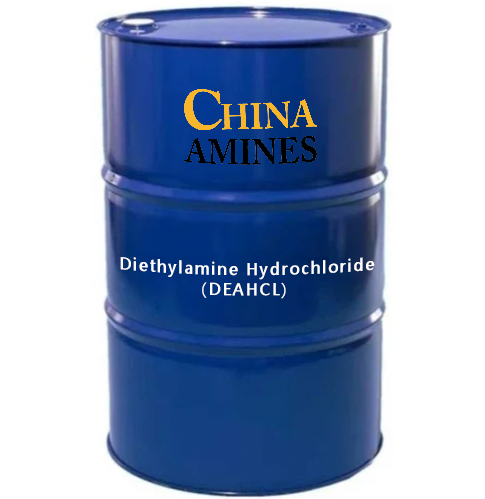1. Chemical Structure and Properties
Molecular Formula: C₄H₁₂ClN
Structural Formula: (CH₂CH₃)₂NH·HCl
A secondary amine hydrochloride formed by neutralizing diethylamine (DEA) with hydrochloric acid.
Physical Properties:
Appearance: White to off-white crystalline powder or hygroscopic solid.
Melting Point: 223–227°C (decomposes).
Solubility: Highly soluble in water (>600 g/L at 25°C), ethanol, and methanol; insoluble in non-polar solvents.
Odor: Odorless (unlike volatile DEA gas).
Hygroscopicity: Absorbs moisture rapidly; requires airtight storage.
Chemical Properties:
Stability: Stable under dry conditions; decomposes upon heating to release DEA and HCl.
Reactivity: Weakly acidic (pKa ≈ 10.9); regenerates DEA upon treatment with strong bases.
2. Industrial Applications
Pharmaceuticals:
- Intermediate for local anesthetics (e.g., lidocaine) and antihistamines (e.g., diphenhydramine).
- Salt Formation: Improves solubility and stability of APIs.
Agrochemicals:
- Herbicide precursor: Key in atrazine and glyphosate production.
- Fungicide intermediate: Utilized in triazole synthesis (e.g., propiconazole).
Organic Synthesis:
- Reagent in alkylation, acylation, and Mannich-type reactions.
- Surfactant precursor: Quaternary ammonium salt production for detergents and softeners.
Electronics:
- Etching agent for silicon wafer processing in semiconductor fabrication.
3. Safety and Toxicology
Health Hazards:
- Limited animal data suggests potential liver/kidney toxicity; not classified as carcinogenic (IARC).
- Skin/Eye Contact: Irritating and corrosive (rabbit skin LD50: ~750 mg/kg).
- Inhalation: Dust and vapors may irritate respiratory system; handle as DEA hazard.
- Ingestion: Moderately toxic (oral LD50 rat: ~1,300 mg/kg); may cause gastrointestinal damage.
Handling Precautions:
- PPE: Nitrile gloves, protective goggles, and N95 respirator for dust control.
- Storage: Store in sealed, moisture-proof containers in cool, dry areas; avoid contact with alkalis.
- First Aid: Rinse affected areas thoroughly with water; seek medical attention for serious exposure.
4. Environmental and Regulatory Compliance
Environmental Impact:
- Aquatic Toxicity: LC50 (fish, 96h): 150–300 mg/L; EC50 (daphnia): 80–150 mg/L.
- Biodegradability: Readily biodegradable (OECD 301D: >70% in 28 days).
- Persistence: Degrades quickly via hydrolysis in aquatic environments.
Regulatory Frameworks:
- GB 13690-2009 (China): Classified as General Chemical; standard safety measures required.
- OSHA (US): No specific PEL; general duty clause applies.
- EPA: Listed on TSCA Inventory.
- CLP (EU): Classified as Skin Irrit. 2 (H315), Eye Irrit. 2 (H319), Acute Tox. 4 (H302).
- REACH (EU): Registered with full SDS and handling documentation.
Transport:
- UN Number: Not classified as hazardous for transport (non-DG).
5. Case Studies and Application Insights
Case 1: Lidocaine Synthesis
- Process: DEA HCl reacts with 2,6-xylidine under catalytic acid to form lidocaine hydrochloride.
- Efficiency: 88% yield at 60°C in optimized batch process (Pfizer).
Case 2: Atrazine Herbicide Production
- Application: DEA HCl reacts with cyanuric chloride to form atrazine.
- Performance: Yields >95% purity with controlled pH conditions (Syngenta process).
Comparative Analysis:
- Pros: Solid form enhances handling safety; reduces flammability risks.
- Cons: Requires regeneration via basification for certain synthetic steps.


